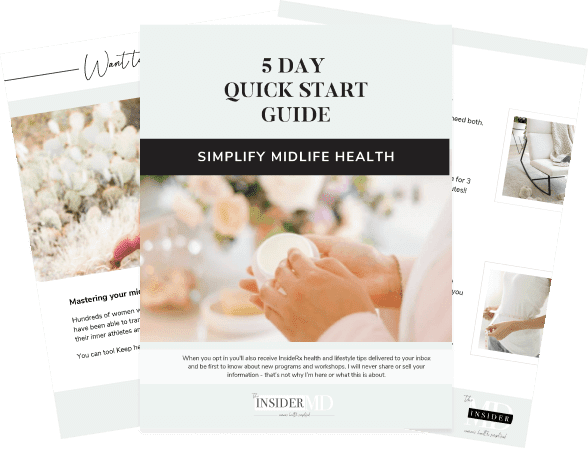
Frozen Shoulder at Midlife: What to Know and How to Manage
If you’ve heard of or been diagnosed with a frozen shoulder – also known as adhesive capsulitis – you know it’s no fun. Movement of your shoulder causes pain and range of motion becomes very limited. It can even interfere with sleep. This post will discuss what a frozen shoulder is and what you should know.
What is a Frozen Shoulder?
A frozen shoulder is a condition that affects your shoulder joint, causing pain and stiffness. It develops gradually, gets worse, and then finally goes away. It typically lasts anywhere from 1 to 3 years.
The shoulder comprises three bones (humerus, shoulder blade, and collarbone) that form a ball-and-socket joint with surrounding tissue that holds everything together. This tissue is called the shoulder capsule.
With a frozen shoulder, the capsule becomes so thick and tight that it’s hard to move. Bands of scar tissue form, and there’s less of a liquid called synovial fluid to keep the joint lubricated.

With a frozen shoulder, the tissues of the shoulder capsule become thick, stiff, and inflamed.
There are typically three stages of frozen shoulder:
- Freezing stage. Any shoulder movement causes pain, and your shoulder’s range of motion starts to become limited.
- Frozen stage. Pain may begin to diminish during this stage. However, your shoulder becomes stiffer, and using it becomes more difficult.
- Thawing stage. The range of motion in your shoulder begins to improve.
For some people, the pain worsens at night, often disrupting sleep.
What Causes a Frozen Shoulder?
The initial trigger for this condition is still unknown.
Women in their 40s and 50s are at a higher risk of getting a frozen shoulder. Many women have reported cases of frozen shoulder that coincided with perimenopause, menopause, or the start or end of hormone replacement therapy. Some experts say changing levels of hormones may be to blame for this connection between frozen shoulder and menopause.
Those who have diabetes are also at greater risk. About 10% to 20% of people with diabetes get frozen shoulder. Other medical problems including heart disease, thyroid disease and Parkinson’s disease are linked to a frozen shoulder. There is a greater risk for people who have had an immobilized shoulder for an extended period for conditions such as an arm fracture or surgery.
Treatment Options
Most frozen shoulders get better on their own within 12 to 18 months. Treatment is mainly aimed at controlling pain and preserving as much range of motion as possible.
Medications
Over-the-counter pain relievers such as aspirin and ibuprofen can help reduce pain and inflammation associated with frozen shoulder.
Physical Therapy
Results with physical therapy are mixed. It may be more helpful during certain phases than others. Range-of-motion exercises can help recover mobility. Doing these exercises regularly is essential to restore mobility. Resting the shoulder may make the condition worse by allowing more adhesions to develop around the shoulder capsule. In addition, using the shoulder helps maintain muscle strength, which can prevent additional problems later on. Remember the adage: “Motion is Lotion.”
Steroid injections
Injecting corticosteroids into your shoulder joint may help decrease pain and improve shoulder mobility, especially in the early stages of the process.
Joint distension
Injecting sterile water into the joint capsule can help stretch the tissue and make it easier to move the joint.
Surgery
Surgery for a frozen shoulder is rarely necessary, but your doctor may suggest surgery to remove scar tissue and adhesions from inside your shoulder joint if nothing else has worked. Doctors usually perform this surgery arthroscopically by inserting lighted, pencil-sized instruments through small incisions around your joint.
Shoulder manipulation
Surgeons would forcefully manipulate the shoulder under general anesthesia to break up adhesions. With this method, there was an increased risk of complications, including fractures. Manipulation is rarely performed anymore because arthroscopic surgery has replaced it.
Frozen Shoulder: Takeaways
- Women over 40 are more likely to experience frozen shoulder.
- The hallmark of frozen shoulder, also known as adhesive capsulitis, is stiffness and pain in the shoulder joint, which begins gradually, worsens over time, and resolves within one to three years.
- The risk increases if you’re recovering from a medical condition or surgery that prevents you from moving your arm, such as a stroke, fracture, or mastectomy.
- Treatment involves range-of-motion exercises and sometimes corticosteroid injections into the joint capsule. In a small number of cases, arthroscopic surgery may be indicated to loosen the joint capsule so that it can move more freely.
- Frozen shoulder does not tend to recur in the same shoulder, but some people can develop it in the opposite shoulder.

MEET DR. ELLEN
My mission is to bring you the most up-to-date, proven medical information, simplified, so you can make confident, educated decisions about your health.
I'M LOOKING FOR...
grab your 5 day
quick start guide



